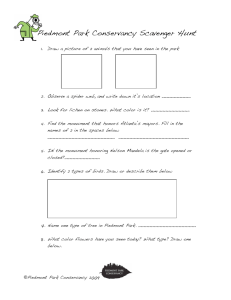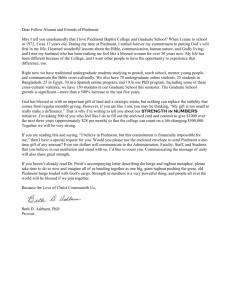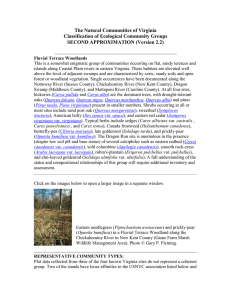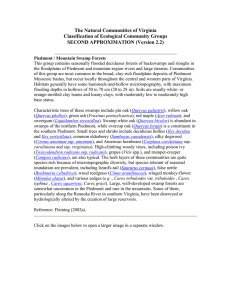The Natural Communities of Virginia Classification of Ecological Community Groups
advertisement
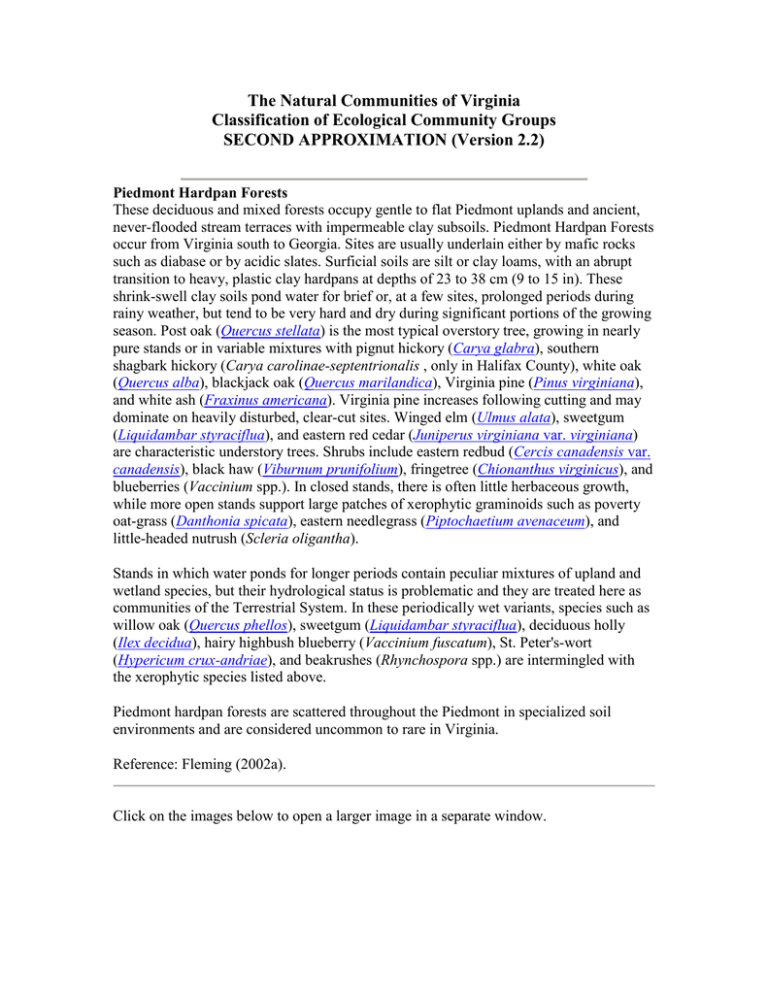
The Natural Communities of Virginia Classification of Ecological Community Groups SECOND APPROXIMATION (Version 2.2) Piedmont Hardpan Forests These deciduous and mixed forests occupy gentle to flat Piedmont uplands and ancient, never-flooded stream terraces with impermeable clay subsoils. Piedmont Hardpan Forests occur from Virginia south to Georgia. Sites are usually underlain either by mafic rocks such as diabase or by acidic slates. Surficial soils are silt or clay loams, with an abrupt transition to heavy, plastic clay hardpans at depths of 23 to 38 cm (9 to 15 in). These shrink-swell clay soils pond water for brief or, at a few sites, prolonged periods during rainy weather, but tend to be very hard and dry during significant portions of the growing season. Post oak (Quercus stellata) is the most typical overstory tree, growing in nearly pure stands or in variable mixtures with pignut hickory (Carya glabra), southern shagbark hickory (Carya carolinae-septentrionalis , only in Halifax County), white oak (Quercus alba), blackjack oak (Quercus marilandica), Virginia pine (Pinus virginiana), and white ash (Fraxinus americana). Virginia pine increases following cutting and may dominate on heavily disturbed, clear-cut sites. Winged elm (Ulmus alata), sweetgum (Liquidambar styraciflua), and eastern red cedar (Juniperus virginiana var. virginiana) are characteristic understory trees. Shrubs include eastern redbud (Cercis canadensis var. canadensis), black haw (Viburnum prunifolium), fringetree (Chionanthus virginicus), and blueberries (Vaccinium spp.). In closed stands, there is often little herbaceous growth, while more open stands support large patches of xerophytic graminoids such as poverty oat-grass (Danthonia spicata), eastern needlegrass (Piptochaetium avenaceum), and little-headed nutrush (Scleria oligantha). Stands in which water ponds for longer periods contain peculiar mixtures of upland and wetland species, but their hydrological status is problematic and they are treated here as communities of the Terrestrial System. In these periodically wet variants, species such as willow oak (Quercus phellos), sweetgum (Liquidambar styraciflua), deciduous holly (Ilex decidua), hairy highbush blueberry (Vaccinium fuscatum), St. Peter's-wort (Hypericum crux-andriae), and beakrushes (Rhynchospora spp.) are intermingled with the xerophytic species listed above. Piedmont hardpan forests are scattered throughout the Piedmont in specialized soil environments and are considered uncommon to rare in Virginia. Reference: Fleming (2002a). Click on the images below to open a larger image in a separate window. Piedmont Hardpan Forest on upland flats underlain by gabbro in Charlotte County (Hogan Creek Wildlife Management Area, John H. Kerr Reservoir). Photo: Gary P. Fleming. REPRESENTATIVE COMMUNITY TYPES: One upland, xerophytic community type, supported by more than a dozen plot samples, has been classified and appears consistent in name and concept with similar vegetation occurring in North Carolina. Very few stands of periodically wet hardpan forest have been found in Virginia and data are insufficient for classification. Click on any highlighted CEGL code below to view the global USNVC description provided by NatureServe Explorer. Quercus stellata – Quercus alba – Carya glabra / Ulmus alata / Piptochaetium avenaceum – Scleria oligantha Forest Piedmont Xeric Hardpan Forest USNVC: = CEGL003714 Global/State Ranks: G3/S2?
